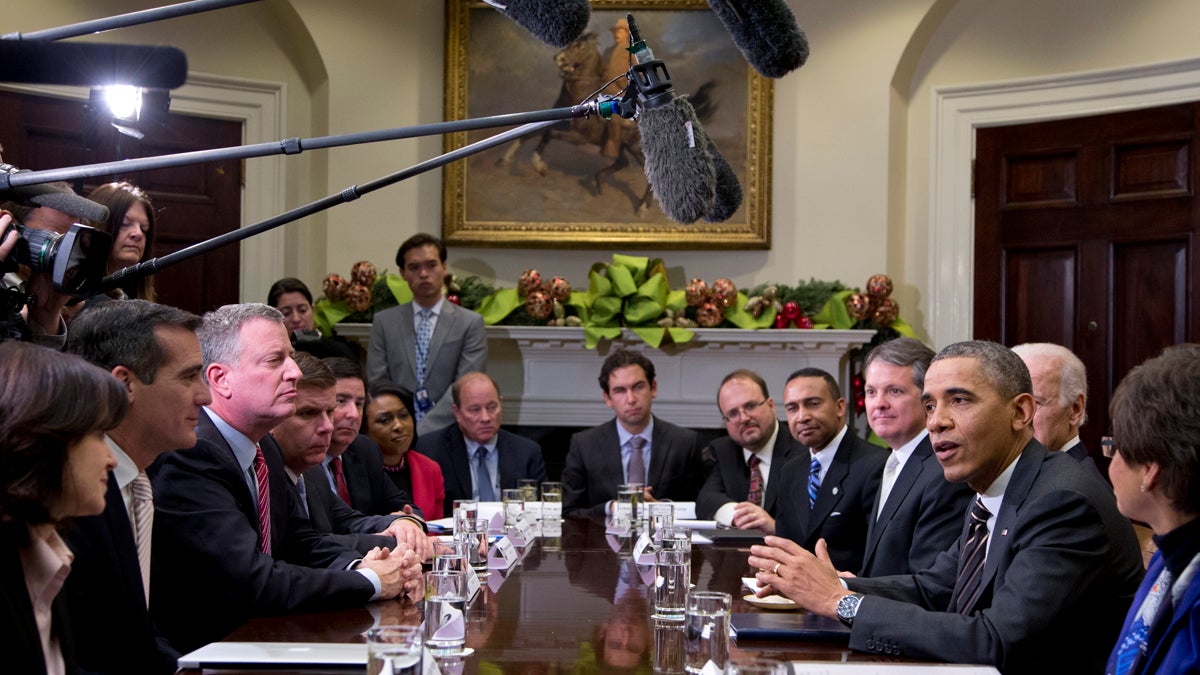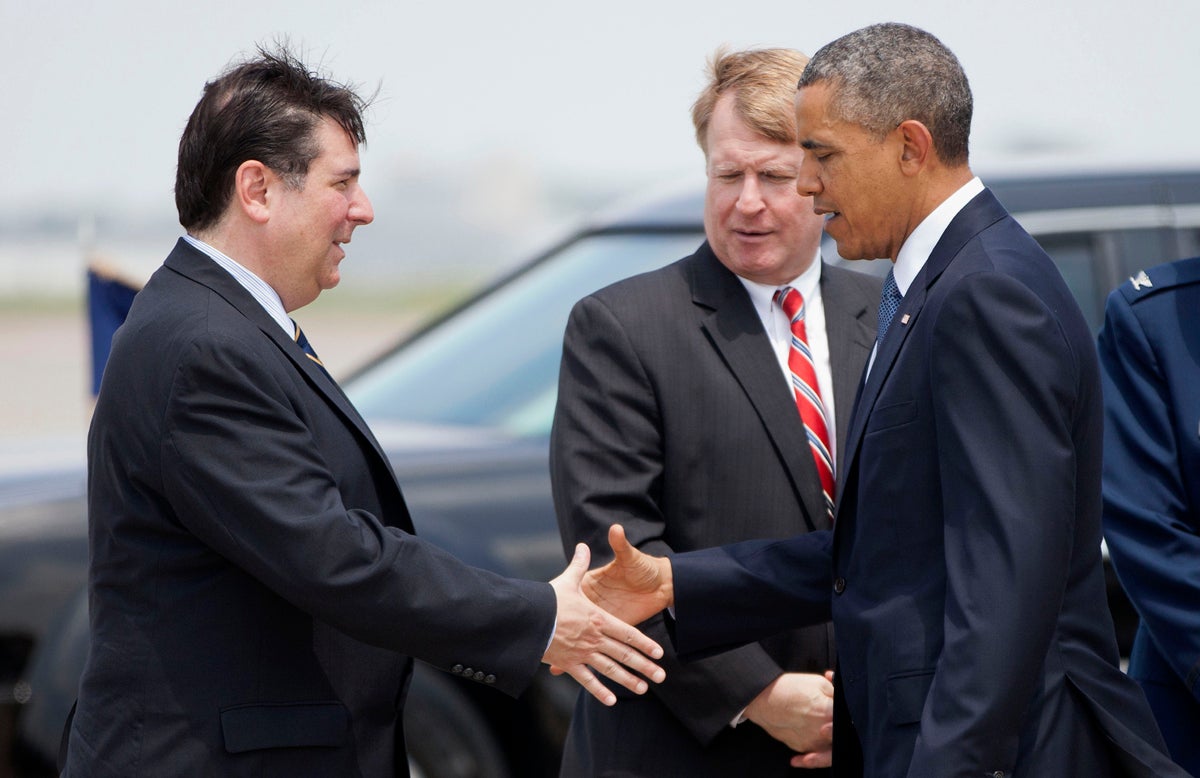A national urban policy? Not so fast

President Barack Obama speaks to media in the Roosevelt Room of the White House in Washington, Friday, Dec. 13, 2013, before a meeting with mayors and newly-elected mayors from across the country . (AP Photo/Carolyn Kaster, file)
Attempts to establish a national urban policy have popped up and failed throughout U.S. history.
Attempts to establish a national urban policy have popped up and failed throughout U.S. history.
For example, in 1959, a Senate subcommittee heard testimony related to two bills. The first to provide for the establishment of a Commission on Metropolitan Problems and the second to provide for the establishment of a Department of Urbiculture.
Experts testified in support of studying urban issues. One of them was the then-mayor of Philadelphia, Richardson Dilworth, who said, “We are justly concerned with developing a national defense policy, a national farm policy, a national fiscal policy, etc. The time is long past due when we developed a national urban policy.”
Neither bill became law that session. Indeed, 50 years later, President Obama found himself making a similar pitch.
The U.S. has never had a national, comprehensive urban policy. The closest the U.S. has come was the New Deal agenda of the 1930s, and the Great Society proposals of the 1960s. The Carter administration attempted to develop an urban agenda, but despite several studies, accomplished little.
In fact, the plight of cities hasn’t always been prioritized. For example, after the Department of Housing and Urban Development was [finally] founded in 1965, it still had relatively little power, despite its cabinet-level seat at the table. Lore has it that President Reagan didn’t even recognize his own HUD Secretary. “He would frequently run into him in meetings and refer to him as “Mr. Mayor” and it was clear that he just thought this black guy must be [a] mayor. That gives you a sense of how much influence HUD had in the ‘80s, if he couldn’t even recognize his own HUD appointee,” said Tracy Neumann, a historian and assistant professor at Wayne State University, in Detroit.
Sure, various initiatives and bills — from the highway spending bill, to HUD funding, to the programs that led to the suburbanization of America — affect cities, but they function as disparate programs, often without a shared goal in place.
In the U.S., roughly one third of the population lives in cities of 100,000 people or more. That number goes up to nearly 40 percent if you include cities of 50,000 people or more. So why isn’t leadership working to address in a holistic way the problems many of these communities share? Turns out, lots of reasons.
Disagreement between cities
One thing to keep in mind is while cities have a lot in common with each other they also have distinct personalities and needs. That’s partly what makes them great. But if you’re trying to make urban policy that will strengthen all cities, that may mean meeting very different requirements.
For example, “there’s this kind of long dichotomy about Southern and Northern cities,” said Neumann. “If you’re talking about urban policy or money for urban areas, what you’re talking about is sending money to areas that are declining, rather than areas that are growing.” Southern Congress members, she said, haven’t had interest in urban programs because they didn’t think they’d help cities like Atlanta, instead focusing on cities like Philadelphia.
So, think large cities vs. small cities. Growing cities vs. struggling cities. Southern cities vs. Northern cities vs. Western cities. That’s a lot of differences!
Disagreement between cities … and everyone else
City leaders may disagree with each other, but perhaps an even bigger issue is they have to compete for resources with everyone else — rural areas and the suburbs.
Think about it this way: Philadelphia’s population in about 1.5 million people. But its metro area is around six million. Pittsburgh’s population is just over 300,000 people. Its metro is 2.4 million. There are many more people who live around cities than live in cities. And all those people have lawmakers representing them in state legislatures and in Congress.
And even though many of them work in cities and use cultural amenities in cities, they may not want to support large fiscal bills for the “city problems” they left behind. So their reps won’t vote for it.
“So you have sort of a two-fold problem. That you have more representation at the suburban and even rural level relative to cities,” said Katherine Levine Einstein, Assistant Professor of political science at Boston University. “We’ve seen demographic changes away from cities over the last four to five decades. And within these big cities you see real struggles to build coalitions and agree on cities’ interests.”
That demographic shift away from cities, by the way, was brought on by those policies —highway construction and home loan practices, for example — that really affected cities but weren’t thought of as urban policy.
All [urban] roads lead to Obama
In addition to rural and suburban dwellers having more representatives, those representatives are getting more conservative.
“We’re seeing in our data a lot of conflict in these conservative state governments,” Einstein said. “And this is actually even true with Republican mayors.”
Congress is also conservative.
That leaves the Executive Branch, aka, President Obama.
In his first term, Obama actually pushed for studying urban issues and implementing something akin to a holistic urban agenda. He set up an Office of Urban Affairs, primarily to help coordinate various programs affecting cities. Pittsburgh Mayor Bill Peduto has worked with the White House and praises those efforts. “They work hand in hand to create an urban agenda that’s more aligned with what cities need. And they look at priority systems between transportation, and planning grants, and environmental issues,” Peduto said.

President Barack Obama is greeted on the tarmac by Pittsburgh Mayor Bill Peduto, left, and Allegheny County Executive Rich Fitzgerald upon his arrival on Air Force One at Pittsburgh International Airport, Tuesday, June 17, 2014, in Pittsburgh, Pa. (AP Photo/Pablo Martinez Monsivais)
Despite Obama’s energetic efforts, his accomplishments have been limited.
The close relationship between mayors and the Executive branch is actually a throwback. For example, Franklin Delano Roosevelt cultivated a direct rapport with urban leaders, before states became more involved.
Today, most of the federal money for cities comes through states, allowing them to retain more control over what happens within their borders. But remember how relationships between mayors and state leadership are strained of late?
Einstein says in surveys mayors just want states to be hands off, while they want more federal regulations.
“I have two theories on this. One is that state and city tend to have policy overlap. The states and cities are often tasked with sort of trying to accomplish similar policy goals. Things like roads, mass transit.” State laws can also limit cities’ ability to raise revenue or pass independent city policies, and can impose unfunded mandates. Peduto, for one, rails against municipal pension laws.
The federal government, on the other hand, has a lot more control over issues without overlap, like immigration, for example. So while state laws are seen as stumbling blocks, mayors see federal regulations as easing certain struggles, especially ones they may otherwise lose to conservative governors. Mayors “want more uniform gun control laws, more uniform marijuana legislation, that sort of thing,” Einstein said.
She added that not all federal policies are welcome (Environmental Protection Agency rules especially get push back) and, when she dug a little deeper, she found mayors’ love for federal regulations was really love for Obama. “I actually wonder, if we do have a conservative president in 2016 whether mayors will become a lot less positive about the federal government,” Einstein said.
The U.S. Conference of Mayors has put together a 16-point list of things for the next president to consider, including protecting streets and neighborhoods, creating affordable housing, and investing in transportation.
Peduto has another ask to add: “Don’t hurt us,” he said. “I think the biggest takeaway is cause no harm.”
WHYY is your source for fact-based, in-depth journalism and information. As a nonprofit organization, we rely on financial support from readers like you. Please give today.


